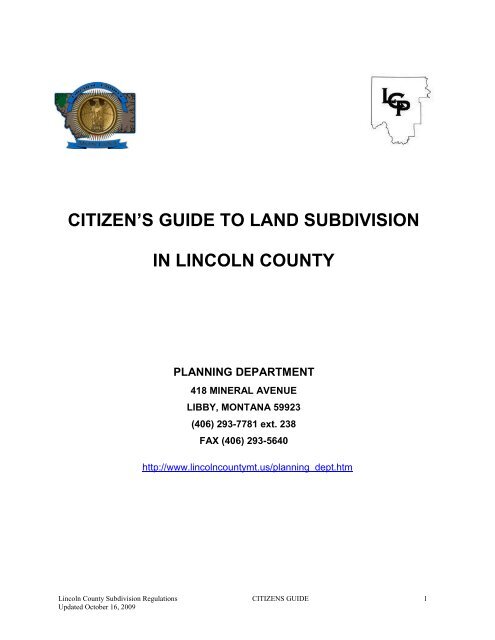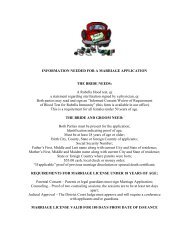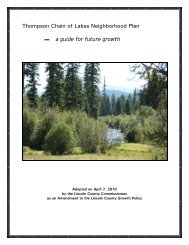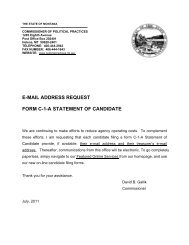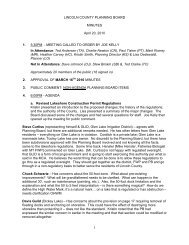Subdivision Regulations - Lincoln County, Montana
Subdivision Regulations - Lincoln County, Montana
Subdivision Regulations - Lincoln County, Montana
Create successful ePaper yourself
Turn your PDF publications into a flip-book with our unique Google optimized e-Paper software.
CITIZEN’S GUIDE TO LAND SUBDIVISION<br />
IN LINCOLN COUNTY<br />
PLANNING DEPARTMENT<br />
418 MINERAL AVENUE<br />
LIBBY, MONTANA 59923<br />
(406) 293-7781 ext. 238<br />
FAX (406) 293-5640<br />
http://www.lincolncountymt.us/planning_dept.htm<br />
<strong>Lincoln</strong> <strong>County</strong> <strong>Subdivision</strong> <strong>Regulations</strong> CITIZENS GUIDE 1<br />
Updated October 16, 2009
Preface<br />
In 1973 the <strong>Montana</strong> Legislature passed the <strong>Subdivision</strong> and Platting Act, (Title 76,<br />
Chapter 3, MCA) which requires local jurisdictions to adopt and enforce local<br />
subdivision regulations. <strong>Lincoln</strong> <strong>County</strong> has had subdivision regulations since that time<br />
and the regulations currently in effect were adopted in April 2004. They describe the<br />
procedures and requirements necessary to create a subdivision. They were adopted to<br />
ensure that the subdivision is in the public interest and the negative impacts are<br />
adequately addressed through the public review process.<br />
This guide is intended to provide a “snapshot” of the subdivision process, some of the<br />
requirements, and some things to think about when considering subdividing. This<br />
document provides important information for both the person contemplating doing a<br />
subdivision and their surrounding neighbors. For a complete understanding of the<br />
details, please refer to the <strong>Lincoln</strong> <strong>County</strong> <strong>Subdivision</strong> <strong>Regulations</strong> available in the<br />
Planning Department, as well as on our website.<br />
Types of <strong>Subdivision</strong><br />
<strong>Subdivision</strong>s by definition include all land divisions that create parcels less than 160<br />
acres. Also included in this definition are mobile home parks, recreational vehicle parks<br />
and certain condominiums. <strong>Subdivision</strong>s are divided into several categories based on<br />
the number of lots/spaces being created.<br />
<br />
<br />
<br />
Major subdivision – contains six or more lots/spaces<br />
Minor subdivision – contains five or fewer lots/spaces.<br />
The <strong>Subdivision</strong> Exemption is another category that involves a change in a<br />
property boundary, but does not require the entire subdivision review process.<br />
These proposals are reviewed in consultation with the Clerk and Recorders<br />
Office and on occasion, the <strong>County</strong> Commissioners (depending on the type of<br />
<strong>Lincoln</strong> <strong>County</strong> <strong>Subdivision</strong> <strong>Regulations</strong> CITIZENS GUIDE 2<br />
Updated October 16, 2009
exemption) to determine whether or not the subdivision regulations apply to the<br />
division. Some examples of subdivision exemptions include:<br />
Family Transfers – A division of land for the purpose of a single gift or sale<br />
to each member of a landowner’s immediate family. “Immediate family”<br />
includes only the spouse of the grantor, or the parent or child of the grantor or<br />
the child of the grantor by blood or adoption.<br />
Agricultural Exemption – Creating a separate piece of land for agricultural<br />
use only.<br />
Relocation of a Common Boundary – Relocating a common boundary(ies)<br />
between adjoining parcels, but no additional parcels are created.<br />
The type of subdivision proposed will dictate the type of review that is required, the<br />
application fees and the development standards.<br />
The <strong>Subdivision</strong> Process<br />
The process to create a subdivision involves a number of steps. Each of which are<br />
dependent on each other. Although the process is rather straightforward, it may be<br />
necessary for the subdivider to modify the proposal based on results from any or all of<br />
the steps. From the very beginning to the final decision of the <strong>County</strong>, it is a process of<br />
discovery for everyone involved.<br />
Step 1.<br />
Preliminary Investigations<br />
Prior to beginning the process of trying to subdivide land, a basic “due diligence” effort<br />
should be undertaken. This involves a trip to the <strong>County</strong> Clerk & Recorder’s Office<br />
(<strong>County</strong> Building, 512 California, Libby) to check if there are any covenants placed on<br />
the property to be subdivided; and consultation with the Department of Environmental<br />
<strong>Lincoln</strong> <strong>County</strong> <strong>Subdivision</strong> <strong>Regulations</strong> CITIZENS GUIDE 3<br />
Updated October 16, 2009
Health (418 Mineral Ave., Libby) to determine if there are any potential septic or well<br />
concerns. If there is a problem in either of these two areas, continuing with the<br />
subdivision process may not be possible.<br />
Given the technical nature of creating a subdivision, the subdivider will normally hire<br />
one or more consultants to assist in the process. Consultants who are familiar with the<br />
requirements can be a valuable asset. The Yellow Pages in your phone book has many<br />
surveyors and consultants listed that have submitted proposals to the <strong>County</strong>.<br />
Below are a number of questions that will help refine a proposal and perhaps suggest<br />
whether a project will work.<br />
Will the subdivision be served by a public water and waste water system or by<br />
individual systems on each of the lots?<br />
Are there any constraints (soil types, high groundwater, etc.), which might limit<br />
the use of septic systems?<br />
Is there enough groundwater to support domestic wells?<br />
How deep will the wells need to be? (Typical cost is $22.00 per foot.)<br />
Will the subject property be able to support the number of septic systems and<br />
wells that may be proposed?<br />
Are the lot sizes consistent with covenants, if any?<br />
Are the lot sizes consistent with zoning regulations, if any? (<strong>Lincoln</strong> <strong>County</strong><br />
currently has NO zoning ordinance.)<br />
Is there legal access to the property? If you access from a Forest Service Road,<br />
do you have the correct authorization/permit?<br />
Does the land pose any constraints for development (wetlands, wildlife habitat,<br />
etc.)?<br />
<strong>Lincoln</strong> <strong>County</strong> <strong>Subdivision</strong> <strong>Regulations</strong> CITIZENS GUIDE 4<br />
Updated October 16, 2009
Does the land pose any opportunities for development (views, natural amenities,<br />
etc.)?<br />
Does the location of the proposed subdivision pose any constraints or<br />
opportunities? (distance to local services, proximity to parks, etc.)<br />
Is the subject property within a rural fire district or service area?<br />
What is the area around the proposed subdivision like (land uses, lot sizes, etc.)?<br />
How much will it cost to go through the process and get it surveyed?<br />
What is the target market?<br />
Is there a demand for the type of lots that would be created? Will that demand<br />
be there when the project is near completion? Is there variability in the product<br />
(various lot sizes) to adapt to a potentially dynamic market?<br />
What amenities are people looking for?<br />
How quickly will the lots need to sell in order for the project to succeed<br />
(absorption rate)?<br />
Does the project financially work?<br />
The success of most projects depends on this first step. If there are no restrictions on<br />
the property; if there appears to be no septic or well issues; and if the above tickler list<br />
suggests a project is viable, then the next step is to meet with the Planning Department.<br />
Step 2.<br />
Pre-Application Conference<br />
Once the subdivider determines that the project seems to have merit, he/she will then<br />
meet with the Planning Department staff to discuss the proposal prior to submitting<br />
application materials and application fees. A pre-application conference is required and<br />
<strong>Lincoln</strong> <strong>County</strong> <strong>Subdivision</strong> <strong>Regulations</strong> CITIZENS GUIDE 5<br />
Updated October 16, 2009
will help the Planning Department staff to become familiar with the proposal and will<br />
help the subdivider become familiar with the <strong>County</strong>’s policies, regulations and<br />
procedures. It also gives the staff an opportunity to identify issues and discuss possible<br />
ways to avoid, minimize, or mitigate negative impacts as well as identify particular<br />
agencies the applicant should contact prior to submitting the application. The form for<br />
this meeting can be found on the Planning Department website.<br />
Step 3.<br />
Submittal of a <strong>Subdivision</strong> Application<br />
Following the pre-application conference, the applicant submits a subdivision<br />
application to the Planning Department, along with the appropriate fee(s). The Planning<br />
Department then reviews the application for completeness and sufficiency.<br />
Step 4.<br />
Public Review<br />
Once the application is deemed sufficient, the application is subject to a public review<br />
process. As part of this process, a letter is sent to all property owners, whose land<br />
adjoins the subject property, notifying them of the project and public notification signs<br />
are posted on the subject property by the subdivider. This notification occurs for a<br />
subsequent minor or major plat application. First time minors do not require this public<br />
notice.<br />
The specific procedural requirements in this step depend on the type of subdivision<br />
(major, minor, subsequent minor) that is being reviewed. Major and minor subdivision<br />
proposals are reviewed by the Planning Department. Based on the proposal, the<br />
Planning Department will offer its recommendation to the Planning Board which will in<br />
turn offer its recommendation to the Board of <strong>County</strong> Commissioners for a final<br />
decision. All proposals are reviewed using criteria established by the State of <strong>Montana</strong>.<br />
<strong>Lincoln</strong> <strong>County</strong> <strong>Subdivision</strong> <strong>Regulations</strong> CITIZENS GUIDE 6<br />
Updated October 16, 2009
Step 5.<br />
Decision<br />
For major and minor subdivisions, based on the Planning Department’s<br />
recommendation and all of the information collected during the review process, the<br />
Board of <strong>County</strong> Commissioners will make a decision to approve the subdivision,<br />
approve with conditions, or deny it. An appeal process allows the subdivider or an<br />
aggrieved party to contest that decision in District Court.<br />
Step 6.<br />
Completion of Conditions<br />
If the subdivision is approved, the Board of <strong>County</strong> Commissioners, in their written<br />
decision, will list the conditions, which must be met before a final survey can be filed.<br />
These conditions ensure that the subdivision will meet legal requirements and protect<br />
the public interest, natural resources and infrastructure from adverse impacts.<br />
Conditions of approval vary depending on the specific circumstances of the subdivision.<br />
One requirement that applies to all subdivisions with lots less than 20 acres is that the<br />
<strong>Montana</strong> Department of Environmental Quality must review the proposal and determine<br />
whether it meets the sanitation standards. Before beginning to build on any lot, a septic<br />
permit must be obtained from the <strong>Lincoln</strong> <strong>County</strong> Environmental Health Department.<br />
Step 7.<br />
File Final Survey<br />
When all of the conditions of an approval have been satisfied, the subdivider will submit<br />
a final survey/plat, as prepared by a registered land surveyor, and verification that the<br />
conditions have been met. Once a final plat has been recorded with the Clerk &<br />
Recorder, the lots can be bought and sold.<br />
Participants in the <strong>Subdivision</strong> Process<br />
<strong>Lincoln</strong> <strong>County</strong> <strong>Subdivision</strong> <strong>Regulations</strong> CITIZENS GUIDE 7<br />
Updated October 16, 2009
As you can see from the previous section, a wide variety of participants are part of the<br />
process. They can be divided into four general groups.<br />
Consumer: The end product of a subdivision process is the creation of lots.<br />
Consequently, the consumer is a key component of any successful project. By<br />
understanding the needs of the consumers in general, and specifically the target<br />
market, a project is more likely to succeed.<br />
Subdivider: Depending on the complexity and size of the project, the subdivider will<br />
need to enlist the expertise of different professionals. Just a few, or all of the following,<br />
may be part of the subdivider’s team:<br />
Financial Institution<br />
Land Use Consultant<br />
Professional Land Surveyor<br />
Professional Engineer<br />
Project Manager<br />
Attorney<br />
Real Estate Professionals<br />
Environmental Specialists<br />
Landscape Architect<br />
Public: Members of the general public are important parts of the decision making<br />
process, in that subdivision decisions are not private agreements between a subdivider<br />
and <strong>County</strong> officials. A public process is necessary because subdivisions normally<br />
create impacts that are public concerns and can ultimately result in the expenditure of<br />
taxpayer dollars. Most issues related to traffic, wildlife, public services, irrigation water<br />
delivery, agricultural land and others are discussed in public hearings in front of the<br />
Board of <strong>County</strong> Commissioners before a final decision is reached.<br />
<strong>Lincoln</strong> <strong>County</strong> <strong>Subdivision</strong> <strong>Regulations</strong> CITIZENS GUIDE 8<br />
Updated October 16, 2009
<strong>County</strong> Officials: This group of people can be further divided into two groups.<br />
o The Board of <strong>County</strong> Commissioners, consisting of three elected officials,<br />
makes the final decisions on land use issues. In making their decisions, the<br />
Commissioners consider the comments and recommendations of the Planning<br />
Department Staff and comments from the general public, in reference to the<br />
impacts a project has on the six review criteria.<br />
o The Planning Board consists of nine members appointed by the<br />
Commissioners. For major subdivisions the Planning Board reviews the staff<br />
report and holds a public meeting, making recommendations to the<br />
Commissioners.<br />
o The Planning Department staff is authorized to implement the administrative<br />
provisions of the <strong>Subdivision</strong> <strong>Regulations</strong>. For each subdivision the staff reviews<br />
the application, visits the site as necessary, and prepares a written staff report.<br />
The staff report documents whether the proposal meets the local subdivision<br />
regulations and analyzes the impacts of the subdivision relative to the review<br />
criteria. The staff works with the subdivider to ensure compliance and also works<br />
with those interested in a particular subdivision to answer their questions.<br />
Review Criteria<br />
The Planning Department staff’s review and the Board of <strong>County</strong> Commissioners’<br />
render a decision regarding an application, based on the following:<br />
<br />
<br />
Does the proposed subdivision meet the standards of the <strong>Lincoln</strong> <strong>County</strong><br />
<strong>Subdivision</strong> <strong>Regulations</strong> and the <strong>Montana</strong> <strong>Subdivision</strong> and Platting Act?<br />
Is the proposed subdivision in the public interest? To determine whether the<br />
proposal would be in the public interest, the following criteria are used:<br />
<strong>Lincoln</strong> <strong>County</strong> <strong>Subdivision</strong> <strong>Regulations</strong> CITIZENS GUIDE 9<br />
Updated October 16, 2009
Impacts on Agriculture: Including effects on the agricultural sector, loss of<br />
agricultural ground, effects on surrounding agricultural activities.<br />
Impacts on Agricultural Water-User Facilities – Including the effect on<br />
irrigation providers, surface water access, etc.<br />
Impacts on Local Services: Including public road system, police and fire<br />
protection, utilities and public schools.<br />
Impacts on the Natural Environment: Including groundwater<br />
contamination, riparian/wetland areas, soil erosion, vegetation and air<br />
pollution and noxious weeds.<br />
Impacts on Wildlife and Wildlife Habitat: Including fisheries and mammals.<br />
Impacts on Public Health and Safety: Including sanitary issues such as<br />
sewage disposal and groundwater contamination, police and fire<br />
protection, wildland fire hazard, traffic safety and the presence of other<br />
known hazards (onsite and offsite) such as high-pressure natural gas<br />
lines, airports, railroads, overhead power lines, industrial activities, mining<br />
activities, irrigation ditches and defined dam inundation areas.<br />
Conditions will be imposed on a subdivision to mitigate its negative effects on the<br />
taxpayers and the community as a whole. Conditions to mitigate may include changing<br />
the number or configuration of lots, realigning roads or easements, installing appropriate<br />
infrastructure and other actions that are appropriate to the specific subdivision.<br />
About the <strong>Subdivision</strong> Application<br />
A subdivision application consists of a subdivision questionnaire, maps that show the<br />
location of the subdivision a preliminary plat map, which shows the subject property and<br />
the proposed layout of the lots. Additionally, supplemental information related to the<br />
subdivision, such as grading and drainage plans, fire risk assessments, environmental<br />
<strong>Lincoln</strong> <strong>County</strong> <strong>Subdivision</strong> <strong>Regulations</strong> CITIZENS GUIDE 10<br />
Updated October 16, 2009
assessments, traffic impact analysis or other relevant information may also be required.<br />
The application constitutes the subdivider’s expressed preference for the development<br />
and the proposed mitigation measures to minimize the adverse impacts. However,<br />
during the review process, the subdivider may modify the proposal based on comment<br />
received by agencies or the public.<br />
Lot Sizes<br />
Many factors affect the question: “How big do the lots have to be?” From a sanitation<br />
standpoint lots need to meet the minimum requirements of the <strong>Montana</strong> Department of<br />
Environmental Quality. Below is a generalized table showing the types of water sources<br />
and sewage disposal systems and the resulting minimum lot size.<br />
Sanitation Guidelines<br />
Type of Water Source Type of Sewage Disposal Minimum Lot Area<br />
Individual Well Individual Septic 1 acre (43,560 sq. ft.)<br />
Public Water Individual Septic 20,000 square feet<br />
Individual Well Public Sewer 20,000 square feet<br />
Public/Community<br />
Water<br />
Public/Community Sewer<br />
None specified<br />
When a subdivision is subject to the restrictions of a covenant, or deed restriction, lot<br />
sizes must conform to the applicable requirements if they are more restrictive than the<br />
sanitation requirements.<br />
<strong>Lincoln</strong> <strong>County</strong> <strong>Subdivision</strong> <strong>Regulations</strong> CITIZENS GUIDE 11<br />
Updated October 16, 2009
While the minimum lot size is often times established by regulation, the optimum lot size<br />
is a product of many factors, including environmental and economic concerns.<br />
Environmental considerations may include slope, streams, wetlands, soils and wildlife<br />
habitat. Economic factors may include road location and length, infrastructure and utility<br />
costs, prevailing lot sizes in the area and the real estate market.<br />
Contrary to popular belief, more lots do not necessarily translate into more profit for the<br />
subdivider. The location, design of a subdivision – how it fits into the neighborhood and<br />
environment – the target market and the quality of homes can affect the success of a<br />
new neighborhood.<br />
From a financial stand point the last lots sold are where the profits come from, since the<br />
first lot sales will go to pay for the land, development costs, etc. Consequently, creating<br />
a high quality subdivision is important so that the last lots will sell and sell in the desired<br />
time frame.<br />
Addressing Consequences of a <strong>Subdivision</strong><br />
Each and every subdivision has consequences for the parcel, adjoining properties and<br />
the community at large. Some can be positive and some negative, some insignificant<br />
and others can be severe. When adverse impacts of a proposal have been identified<br />
during the preliminary investigations, the pre-application conference, or through the<br />
public review process, the subdivider should take steps to help identify potential ways to<br />
address them. There are three primary ways to address impacts, which should be used<br />
in order: Avoid, Minimize, Mitigate.<br />
Design and Development Standards<br />
To help avoid adverse impacts of subdivisions on the general public and on the<br />
surrounding landowners, the <strong>County</strong> has adopted minimum design and development<br />
standards.<br />
<strong>Lincoln</strong> <strong>County</strong> <strong>Subdivision</strong> <strong>Regulations</strong> CITIZENS GUIDE 12<br />
Updated October 16, 2009
Design Standards – Specific standards must be met for lot design and configuration,<br />
access, road alignment, etc.<br />
Development Standards – Infrastructure improvements are generally required to be<br />
designed, installed, and paid for by the developer as a condition of subdivision approval.<br />
A Professional Engineer must certify in writing that the required improvements have<br />
been completed to <strong>County</strong> standards. Depending on the proposal, a subdivider may<br />
need to provide all or just a few of the following:<br />
<br />
<br />
<br />
<br />
Roads – New roads internal to a subdivision must be built to <strong>County</strong> subdivision<br />
regulations standards and become the responsibility of the homeowners for<br />
maintenance when complete. Existing roads leading to and /or adjacent to the<br />
proposed subdivision may need to be upgraded and improved to handle the<br />
anticipated traffic generated by the subdivision. The road standards in terms of road<br />
width and construction requirements increase as the number of lots that the road<br />
serves increases – more lots means higher standards. Other requirements for road<br />
name signs, traffic control signs and common driveway approaches are imposed<br />
when appropriate.<br />
High Fire Hazard Areas – If the subject property is located in a high fire hazard<br />
area, the subdivider may need to do some vegetation reduction.<br />
Fences – If the subject project is located next to railroad tracks or if a major<br />
irrigation supply ditch is located within or adjacent to the subdivision, a fence may be<br />
required to provide a reasonable degree of safety for the people who will be living on<br />
the lots.<br />
Irrigation Facilities – If the subject property has irrigation water rights the<br />
subdivider will have to either remove the water rights from the property or comply<br />
with the requirements of the local irrigation district. If the subdivision is in an<br />
irrigation district, the district will need to sign off on compliance to their requirements.<br />
<strong>Lincoln</strong> <strong>County</strong> <strong>Subdivision</strong> <strong>Regulations</strong> CITIZENS GUIDE 13<br />
Updated October 16, 2009
Electricity and Telephone Service – The subdivider must provide a service<br />
connection to the subdivision.<br />
Water and Wastewater – If the lots will not be served by an individual well and<br />
septic system, the subdivider must install a central water system and/or sewage<br />
disposal system. If an individual well and septic system are to be used, they must<br />
be designed to meet the minimum standards of the <strong>Montana</strong> Department of<br />
Environmental Quality. Typically, the homeowner and not the subdivider, installs<br />
and pays for these systems.<br />
Mail Service – A central mailbox for all of the lots may be required if mail delivery<br />
will not be provided to each individual lot.<br />
Fire Protection – Each lot in the subdivision should be located within the<br />
boundaries of a fire district. A subdivision served by a municipal water system must<br />
include fire hydrants, the number and placement of which must be approved by the<br />
fire chief.<br />
Storm Water Drainage – Stormwater drainage facilities must be provided to prevent<br />
damage to the subdivision or to adjoining properties.<br />
Noxious Weed Control – The subdivider is responsible for ensuring that noxious<br />
weeds are controlled in the subdivision, especially on areas such as roadways.<br />
Parks – If the project is a major subdivision, the subdivider must either dedicate a<br />
portion of the subdivision for park purposes or contribute money to the <strong>County</strong> Park<br />
fund.<br />
Application Fees<br />
In order that <strong>County</strong> taxpayers do not bear the full cost of reviewing subdivision<br />
applications, the subdivider must pay review fees. Fees may be increased from time to<br />
time. Contact the Planning Department for a list of current fees.<br />
<strong>Lincoln</strong> <strong>County</strong> <strong>Subdivision</strong> <strong>Regulations</strong> CITIZENS GUIDE 14<br />
Updated October 16, 2009
Development Costs<br />
Besides the application fees, there are a number of costs that a subdivider will incur as<br />
shown below. These should be factored into the project’s financial feasibility.<br />
<br />
<br />
<br />
Consultant’s fees<br />
Surveying fees<br />
Infrastructure development costs<br />
The infrastructure development costs can include, but are not limited to:<br />
<br />
<br />
<br />
<br />
<br />
<br />
<br />
<br />
<br />
Roads<br />
Bridges<br />
Stormwater facilities<br />
Water and wastewater<br />
Utilities (telephone and electric)<br />
Road signs<br />
<strong>Subdivision</strong> entrance Signage<br />
Fencing<br />
Park requirements<br />
<strong>Lincoln</strong> <strong>County</strong> <strong>Subdivision</strong> <strong>Regulations</strong> CITIZENS GUIDE 15<br />
Updated October 16, 2009
Variances<br />
As discussed earlier, design and development standards have been adopted to help<br />
ensure proper development. However, there may be instances where the standards<br />
would cause a hardship or would cause unintended results. In these instances, it may<br />
be appropriate for the <strong>County</strong> to issue a variance from that standard. The <strong>Subdivision</strong><br />
<strong>Regulations</strong> list the requirements and procedures for reviewing applications and under<br />
what conditions one may be granted.<br />
For Further Information<br />
For more information please refer to the <strong>Lincoln</strong> <strong>County</strong> <strong>Subdivision</strong> <strong>Regulations</strong> on the<br />
web at http://www.lincolncountymt.us/subdivision_regulations.htm or contact the<br />
Planning Department staff at (406) 293-7781 EXT 238.<br />
<strong>Lincoln</strong> <strong>County</strong> <strong>Subdivision</strong> <strong>Regulations</strong> CITIZENS GUIDE 16<br />
Updated October 16, 2009


